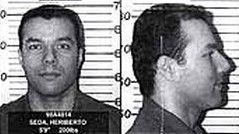
b: 1967
Heriberto "Eddie" Seda
Summary
Name:
Nickname:
The Brooklyn Sniper / The Copycat Zodiac Killer / Faust / The New York Zodiac KillerYears Active:
1990 - 1993Birth:
July 31, 1967Status:
ImprisonedClass:
Serial KillerVictims:
9Method:
ShootingNationality:
USA
b: 1967
Heriberto "Eddie" Seda
Summary: Serial Killer
Name:
Heriberto "Eddie" SedaNickname:
The Brooklyn Sniper / The Copycat Zodiac Killer / Faust / The New York Zodiac KillerStatus:
ImprisonedVictims:
9Method:
ShootingNationality:
USABirth:
July 31, 1967Years Active:
1990 - 1993Date Convicted:
June 24, 1998bio
Heriberto Seda was born on July 31, 1967, in New York City, New York.
murder story
Heriberto Seda attacked people in New York City from 1990 to 1993. He shot nine people during this time, three of whom died. After each attack, he sent letters to the police and media. These letters included codes based on International maritime signal flags. A journalist decoded some of these messages with the help of a World War II veteran.
In his letters, Seda claimed that he chose his victims based on their zodiac signs. He suggested that he would only strike when certain stars were visible in the night sky. To add to his cunning, he used improvised guns, which he believed would prevent police from matching the bullets to him.
Seda's crimes caught the attention of law enforcement, and they initially wondered if he was connected to the Zodiac Killer from the late 1960s. However, experts ruled out that possibility after analyzing Seda's handwriting.
On June 18, 1996, Seda was arrested following a family violence incident. He threatened his half-sister and her boyfriend with a weapon. During the confrontation, he shot his sister in the buttocks. After hours of standoff with the police, he surrendered.
Although authorities did not connect this arrest to the unsolved shootings at first, they later found a symbol in his statement resembling one used in his letters. This led them to investigate him as a suspect. Forensic evidence, including tool marks and fingerprints, linked Seda to the string of shootings. They also found his DNA on a stamp used to send a letter to the police.
Seda caused disruptions in court during his trial. On June 24, 1998, a jury convicted him after a six-week trial. He received a sentence of 232 years in prison.